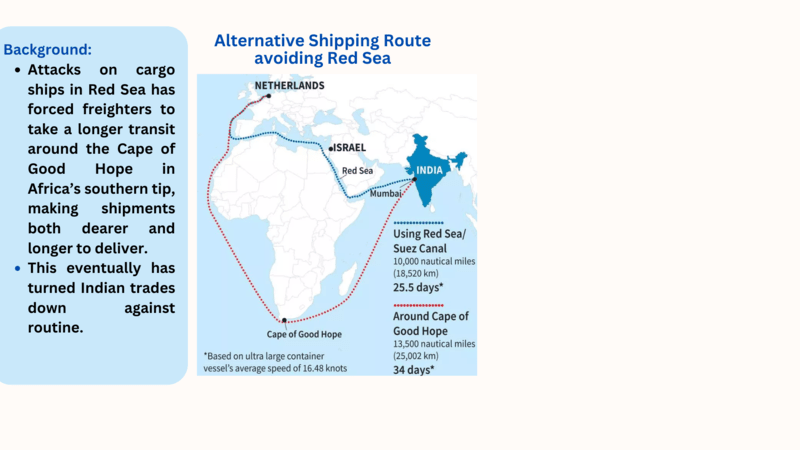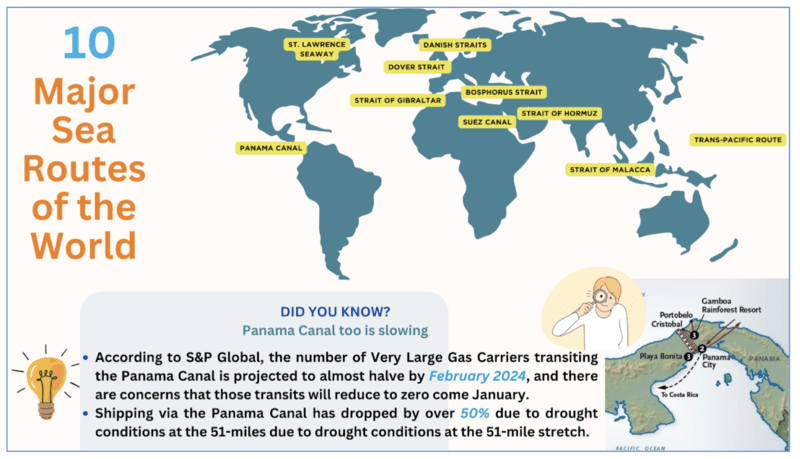How has the Red Sea trouble impacted India?
"Whoever rules the waves rules the world," - Alfred Thayer Mahan (on the influence of Seapower)
Relevance: GS II and III (International Relations and Economics)
- Mains: Indian Trades and Relations; International Maritime Security;
Why in the News?
A spate of attacks on cargo ships in the Red Sea since November 2023 by the Houthi militia of Yemen has made the quickest marine route linking Asia with Europe through the Suez Canal unsafe.

What is the impact on Indian Trade flowing through the Red Sea?
- Longer Route and Increase in Freight’s Time and Cost: After the attacks, almost 90% of western hemisphere cargo, both inbound or shipped from India, that used to go through the Red Sea is now getting re-routed through the Cape of Good Hope(Africa). The remaining 10% of Indian import or export cargo is either not moving or using a transit facility.
- The impact of this move varies on the type of buyer-seller contract.
-
- If it is FOB (free on board), the freight burden is on the buyer (they expect the Indian exporter to hold back consignment), and in CIF (cost, insurance, and freight) or C&F (cost and freight) contracts, the freight has to be borne by the exporter.
- Similarly, exporters who have to bear the freight are requesting their buyers to allow them to hold the consignment given the increase in freight costs, which includes peak season surcharge and contingency surcharge.
- However, if there is zero inventories, the buyer would insist on the shipment of the goods. According to the Container Corporation of India, about 25% of its containers are being held back by Indian exporters.
- Sectors affected: The European Union is one of India’s second-largest export destinations. Slowing demand from the region has impacted India’s labor-intensive sectors, such as textiles, gems, and jewelry exports.
- Particular sector impacted: The worst Commodities affected are chemicals, plastic, and petrochemicals, due to the unavailability of margins to absorb the hike in freight.
- For high-value, low-volume commodities airlifting is possible, but goods that are moved are generally large volumes.
- Agricultural Sector: Disruption in the Red Sea route has turned to increase Indian agricultural product prices by 10-20% as shipments reroute through the Cape of Good Hope.
How does the Red Sea crisis impact India’s Imports?
- Costlier Imports: The recent developments have made imports costlier and call for better inventory management. While the impacts on some critical imports are being assessed, both import and export cycles have elongated.
- Final products turning dearer:
- Crude oil and petroleum products: The Red Sea crisis could come in the way of any plans to reduce pump prices of petrol and diesel. Gross imports of crude oil and petroleum products as a share of India’s gross imports in value terms was 25.8% in 2022-23, and 22.6% in the first half of the current fiscal.
- India’s Higher Dependence: India’s import dependence (based on consumption) in the April-September 2023 period was 87.6%, according to the government’s Petroleum Planning and Analysis Cell. Citing the turbulent situation, there was no plan to slash fuel prices.
- Freight rates increased: Additional war risk premiums in the Red Sea have partially contributed to the freight-rate increases for the relevant routes, but this surcharge is significantly lower than the costs linked to re-routing via the Cape of Good Hope.
|
Conclusion:
New challenges in the Maritime security domain expect a newer outlook for security. States need to undertake a developmental approach while adopting integrated operations to set domestic regulations with international laws and frameworks parallelly.
BEYOND EDITORIAL:
Some Initiatives taken by the Indian Government w.r.t Maritime Security in Global South:
- Indo-Pacific Oceans Initiative (IPOI): The IPOI proposes cooperation in seven sectors (or ‘pillars’) – Maritime security; maritime ecology; maritime resources; capacity building and resource sharing; disaster risk reduction and management; science, technology, and academic cooperation; trade, connectivity, and maritime transport.
- India’s Maritime Vision 2030: This program has set out a 10-year blueprint for the maritime sector, which envisages the development of ports, shipping, and inland waterways as a way of generating growth and livelihoods.

Mains PYQ
Q. Mention the significance of straits and isthmus in international trade. (UPSC 2022)
Q. With respect to the South China Sea, maritime territorial disputes and rising tension affaire the need for safeguarding maritime security to ensure freedom of navigation and ever flight throughout the region. In this context, discuss the bilateral issues between India and China (UPSC 2014)
Q. In 2012, the longitudinal marking for high-risk areas for piracy was moved from 65 degrees east to 78 degrees east in the Arabian Sea by the International Maritime Organisation. What impact does this have on India’s maritime security concerns? (UPSC 2014)


